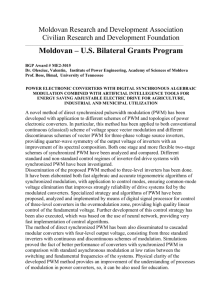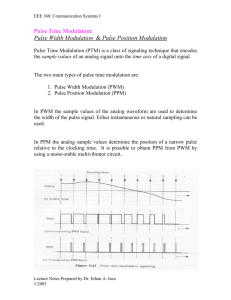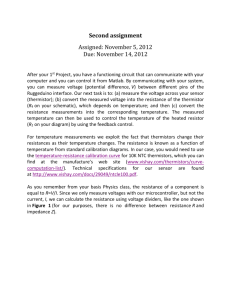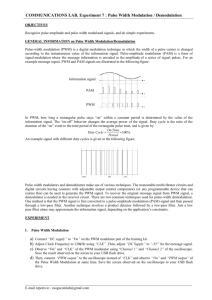Document
advertisement
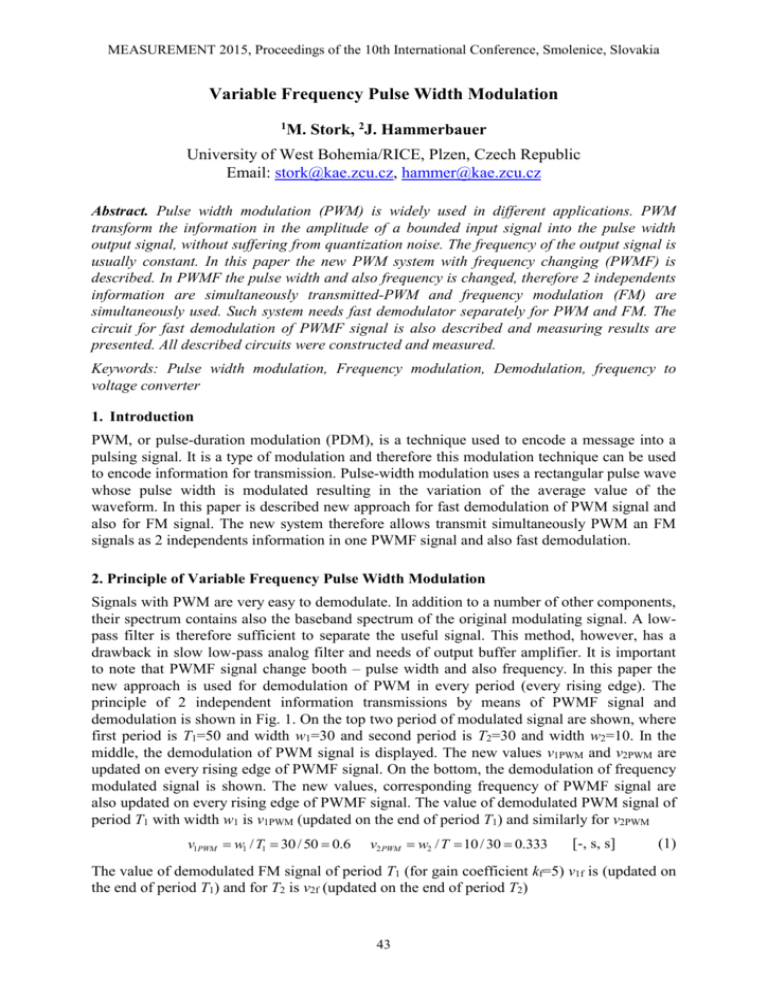
MEASUREMENT 2015, Proceedings of the 10th International Conference, Smolenice, Slovakia Variable Frequency Pulse Width Modulation 1 M. Stork, 2J. Hammerbauer University of West Bohemia/RICE, Plzen, Czech Republic Email: stork@kae.zcu.cz, hammer@kae.zcu.cz Abstract. Pulse width modulation (PWM) is widely used in different applications. PWM transform the information in the amplitude of a bounded input signal into the pulse width output signal, without suffering from quantization noise. The frequency of the output signal is usually constant. In this paper the new PWM system with frequency changing (PWMF) is described. In PWMF the pulse width and also frequency is changed, therefore 2 independents information are simultaneously transmitted-PWM and frequency modulation (FM) are simultaneously used. Such system needs fast demodulator separately for PWM and FM. The circuit for fast demodulation of PWMF signal is also described and measuring results are presented. All described circuits were constructed and measured. Keywords: Pulse width modulation, Frequency modulation, Demodulation, frequency to voltage converter 1. Introduction PWM, or pulse-duration modulation (PDM), is a technique used to encode a message into a pulsing signal. It is a type of modulation and therefore this modulation technique can be used to encode information for transmission. Pulse-width modulation uses a rectangular pulse wave whose pulse width is modulated resulting in the variation of the average value of the waveform. In this paper is described new approach for fast demodulation of PWM signal and also for FM signal. The new system therefore allows transmit simultaneously PWM an FM signals as 2 independents information in one PWMF signal and also fast demodulation. 2. Principle of Variable Frequency Pulse Width Modulation Signals with PWM are very easy to demodulate. In addition to a number of other components, their spectrum contains also the baseband spectrum of the original modulating signal. A lowpass filter is therefore sufficient to separate the useful signal. This method, however, has a drawback in slow low-pass analog filter and needs of output buffer amplifier. It is important to note that PWMF signal change booth – pulse width and also frequency. In this paper the new approach is used for demodulation of PWM in every period (every rising edge). The principle of 2 independent information transmissions by means of PWMF signal and demodulation is shown in Fig. 1. On the top two period of modulated signal are shown, where first period is T1=50 and width w1=30 and second period is T2=30 and width w2=10. In the middle, the demodulation of PWM signal is displayed. The new values v1PWM and v2PWM are updated on every rising edge of PWMF signal. On the bottom, the demodulation of frequency modulated signal is shown. The new values, corresponding frequency of PWMF signal are also updated on every rising edge of PWMF signal. The value of demodulated PWM signal of period T1 with width w1 is v1PWM (updated on the end of period T1) and similarly for v2PWM v1PWM w1 / T1 30 / 50 0.6 v2 PWM w2 / T 10 / 30 0.333 [-, s, s] (1) The value of demodulated FM signal of period T1 (for gain coefficient kf=5) v1f is (updated on the end of period T1) and for T2 is v2f (updated on the end of period T2) 43 MEASUREMENT 2015, Proceedings of the 10th International Conference, Smolenice, Slovakia v2 f k f / T2 5 / 30 0.166 v1 f k f / T1 5 / 50 0.1 [-, s, s] (2) The circuit and measuring results for conversion of PVM signal to voltage and FM signal to voltage in one period (updated on every rising edge) is described in next part. PWMF 1 T T 1 2 0.5 D D 1 2 0 0.8 0 10 20 30 40 V PWM 0.6 V 0.4 50 60 70 80 90 100 80 90 100 80 90 100 1PWM V 0.2 2PWM 0 0 10 20 30 40 50 60 70 V f 0.3 0.2 V V 0.1 0 0 10 20 30 2f 1f 40 50 60 70 Time Fig. 1. The principle of PWMF modulation and fast demodulation (in every cycle – on rising edge of PWMF). Top - PWMF modulated signal, middle - PWM signal demodulation, bottom - demodulation of frequency modulation. 3. Circuit for Fast PWM Demodulation For fast demodulator of PWM the IC’s LTC2644 was used [1]. The simplified block diagram of LTC2644 is shown in Fig. 2 (left). The LTC2644 measures the period and pulse width of the PWM input signals and updates the voltage output DACs after each corresponding PWM input rising edge The input frequency is between 30 Hz and 6.25 kHz (12-bit), 25 kHz (10bit) or 100 kHz (8-bit). The DAC outputs update and settle to 12-bit accuracy within 8μs typically. The most important is that slow analog filter was eliminated. The LTC2644 has a full-scale output of 2.5V using the 10ppm/°C internal reference. The circuit operates from a single 2.7V to 5.5V supply and supports PWM input voltages from 1.71V to 5.5V [2-3]. The demodulated output voltage VDEM can be calculated by the following equation VDEM VREF t1 / T [V, s] (3) where VREF is 2.5 V internal reference voltage (or external reference voltage) and t1 is width of PWM signal and T is period of PWM signal. The measured example of PWM demodulation on every rising edge of input signal is shown in Fig. 2 (right). 5 1 VCC 5 IOVCC 7 PD 4 IDLSEL 9 IN A PWM TO BINARY DAC A VOUTA 2 8 IN B PWM TO BINARY DAC B VOUTB 3 10 0.1 F REF LTC2644 GND GND REFSEL 11 6 12 Fig. 2. The circuit diagram of 2 channel PWM/V converter LTC2644 (left). PWM inputs are 8 and 9, voltage outputs are 2 and 3. The scope of measured the PWM demodulation in every cycle of PWM signal time evoluation of signals (right). The PWM signal (top), demodulated voltage output (bottom). The output of the demodulator is updated every rising edge of input signal. 44 MEASUREMENT 2015, Proceedings of the 10th International Conference, Smolenice, Slovakia 4. Circuits and Measuring Results In this part the circuits and measuring results are presented. The PWMF modulator based on LTC6992 is displayed in Fig. 3 [4]. VPWM is analog input voltage for PWM modulation and VFM is analog input voltage for FM modulation. Applying a voltage between 0V and 1V on the MOD pin sets the duty cycle. The frequency range is from 3.81 Hz to 1 MHz. For fixed PWM frequency (without FM modulation) a single resistor, RSET, programs the LTC6992’s internal master oscillator frequency. The output frequency is determined by this master oscillator and an internal frequency divider, divide by NDIV, which is programmable to eight settings from 1 to 16384 (by means of R1 and R2) [4]. For RFM (fixed PWM frequency) the output PWM frequency is given f out 5 1010 1 ; N DIV 1, 4...16384 N DIV RSET 1 V PWM 6 MOD OUT 2 V GND R FM V FM 3 LTC6992 SET DIV [Hz, Ω] (4) PWMF 5 M1 4 R SET R1 R2 Fig. 3. The circuit diagram of PWMF modulator with LTC6992 IC’s. VPWM is analog input voltage for PWM modulation and VFM is analog input voltage for FM modulation. V PWM PWM & FM V FM MPG PWMF PWM / V V FM PWM / V V PWM Fig. 4. The circuit diagram of PWMF modulator/demodulator with galvanic separation (left) and scope - time diagram of 2 independent signal transmission (right). PWM & FM – modulator (LTC6992), MPG – monostable pulse generator on every rising edge of PWMF, PWM/V – demodulator (LTC2644). The example of transmission 2 signals by means of PWMF. First (Top) – PWM modulator input signal, second – FM modulator input signal, third - demodulated PWMF signal, PWM output, bottom – demodulated PWMFsignal, FM output. When the FM is also used, the output frequency is fout 5 1010 IT 5 1010 N DIV VSET N DIV VSET 1 1 VSET RSET RFM 45 VFM ; N DIV 1,4,...16384 RFM [Hz, V, A] (5) MEASUREMENT 2015, Proceedings of the 10th International Conference, Smolenice, Slovakia The block diagram of circuit for PWMF modulation/demodulation (with isolation barrier) of 2 separate signals is presented in Fig. 4 (left). For FM demodulation, on the first, monostable pulse generator (MPG) is used and output of MPG is connected to one of PWM/V demodulator. The MPG converts FM to PWM. For PWM to voltage the LTC2644 (according Fig. 2 (left)) is used. Result is shown in the Fig. 4 (right). The scope of modulation and demodulation of the PWMF signals are shown. The input (square wave, frequency=35 Hz) analog signal is on the top is connected on PWM input of PWM & FM circuit, the second (sine wave, frequency = 300 Hz) signal is connected on FM modulation input of PWM & FM circuit, the third, is demodulated output VPWM of PWMF signal and bottom is demodulated output of VFM signal. 5. Conclusion In this paper was described new approach for fast demodulation of PWM signal and also for FM signal demodulation. The new system therefore allows transmit simultaneously PWM an FM signals as 2 independents information in one - PWMF signal. The demodulator measures the period and pulse width of the PWM input signals and updates the voltage output DACs after each corresponding PWM input rising edge. The basic PWM demodulator is not sensitive for input frequency changes. The DAC outputs update and settle to 12-bit accuracy within 8μs typically. The most important is that slow low-pass analog filter was eliminated. The fast demodulator can be also separately used as PWM demodulator, FM demodulator (the MPG circuit must be added, see Fig. 4) and demodulator for asynchronous sigma-delta modulator. The presented systems were described, simulated, constructed and measured. Acknowledgements This research has been supported by the European Regional Development Fund and the Ministry of Education, Youth and Sports of the Czech Republic under the Regional Innovation Centre for Electrical Engineering (RICE), project No. CZ.1.05/2.1.00/03.0094 and by the Internal Grant Agency of University of West Bohemia in Pilsen, the project SGS-2015002. References [1] PWM to DC in One Cycle.http://cds.linear.com/docs/en/product-selectorcard/2PB_2645f. pdf, 2015. [2] Convert PWM Inputs to 12-Bit Accurate Voltage Outputs with No Software, No Ripple & No Delay, http://cds.linear.com/docs/en/press-release/LTC2645.pdf, 2015 [3] LTC2644 - Dual 12-/10-/8-Bit PWM to VOUT DACs with 10ppm/°C Reference, http://www.linear.com/product/LTC2644, 2015. [4] LTC6992-1/LTC6992-2/,LTC6992-3/LTC6992-4, Voltage-Controlled Pulse Modulator, http://cds.linear.com/docs/en/press-release/LT6992.pdf, 2015. 46 Width

